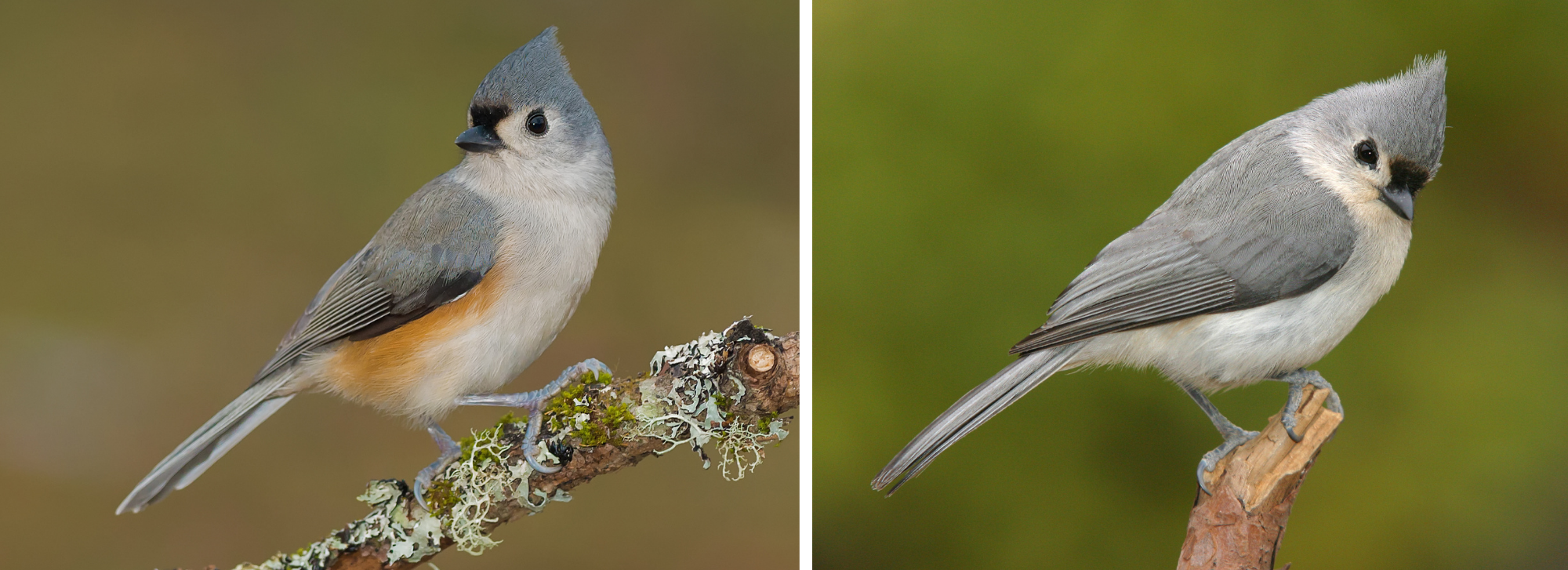Description and Ecology
The Tufted Titmouse (Baeolophus bicolor) is a small (~15 cm), vocal songbird in the Paridae family, a songbird family primarily of the Northern Hemisphere, which also includes chickadees and other titmice. It is one of five North American titmouse species, but this only one commonly found in the Eastern North America. Other members of the Paridae family occurring in North America include the Black-capped Chickadee (Poecile atricapillus), Carolina Chickadee (Poecile carolinensis), and the Bridled Titmouse (Baeolophus wollweberi) of the southwestern U.S. Of these species, the Black-capped Chickadee is the only one regularly found in the Great Lakes Region. The Tufted Titmouse is distributed from southern Ontario to Texas and Florida.

Tufted Titmice are non-migratory birds, remaining within a single region year-round. They prefer deciduous or mixed woodlands, particularly those with mature trees and a dense understory. They also commonly occur in oak woodland-savannas, such as the large tract found at Turkey Point Provincial Park. Tufted Titmice are also adaptable to human modified landscapes, especially urban parks with large, widely spaced trees. While many songbirds are small and gray, the distinctive head crest, large black eyes, and echoing vocalizations of Tufted Titmice make them easy to identify. Their most familiar song is a whistled mnemonic “peter-peter-peter” or “here-here-here,” though they also produce a wide variety of nasal calls, scolds, and buzzy notes, especially during the late winter and spring breeding season.
As typical for other nonmigratory songbirds, Tufted Titmice are sexually monogamous and form long-term pair bonds. They typically raise only one brood per year, though second broods can occur in the southern parts of their range along the U.S. Gulf Coast. Nests are usually constructed in tree cavities, old woodpecker holes, or artificial nest boxes, lined with moss, bark, fur, and animal hair. Female titmice lay on average 6 white or cream-colored eggs, speckled with reddish-brown markings. She incubates them for 12–14 days. After hatching, both parents feed and care for nestlings until they fledge 15–16 days later.
The Tufted Titmouse is omnivorous, with a diet largely composed of insects, seeds, nuts, and berries. During the summer breeding season, they consume large numbers of caterpillars (Lepidoptera), beetles (Coleoptera), wasps and ants (Hymenoptera), flies (Diptera), spiders (Araneae), and snails. In fall and winter, they switch to acorns (Quercus sp.), beechnuts (Fagus sp.), sunflower seeds (Helianthus sp.), and the fruits of cherry (Prunus sp.), grapevines (Vitis sp.), dogwood (Cornus sp.), sumac (Rhus sp.), bayberry (Morella pensylvanica), and hackberry (Celtis sp.). Tufted Titmice are frequent visitors at backyard feeders, especially in winter, where they take sunflower seeds, suet, and peanuts, often flying off to cache food in tree bark or crevices.
Tufted Titmouse populations have been increasing steadily, attributed in part to the installation of bird feeders and nest boxes, which they commonly visit, as well as increases in suitable habitat. Ornithologists estimate their breeding population at around 12 million. Tufted Titmice are now common year-round residents in many parts of the southern Great Lakes region. They have definitely benefitted from habitat restoration efforts achieved by land conservancies (i.e., Nature Conservancy of Canada, Long Point Basin Land Trust), which has expanded the area of open forests and shrublands – their preferred breeding habitat.
Fun facts
- Occasionally, a juvenile Titmouse from a previous year will remain and help feed the new brood during the following breeding season
Written by Matthew Palarchio, HBSc in Environmental Sciences, Western University
All photos are Stock photos retrieved from Canva
The species you’ve just read about—and the ecosystems they depend on—need our protection. Support the work of the Long Point Basin Land Trust and help preserve the wild spaces of the Long Point Basin: https://longpointlandtrust.ca/donate
To view a directory of all species featured on our website, visit: https://longpointlandtrust.ca/featured-species

